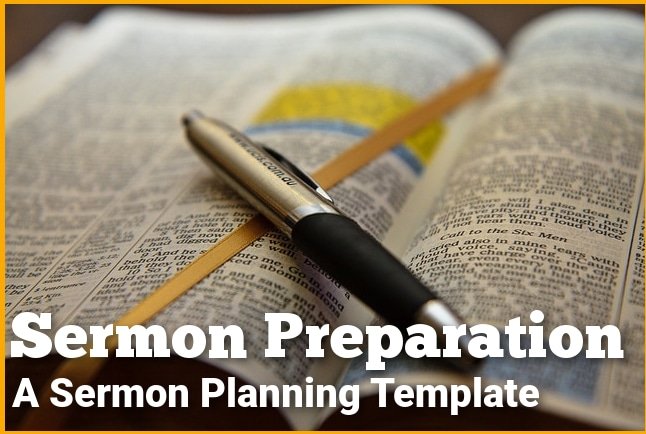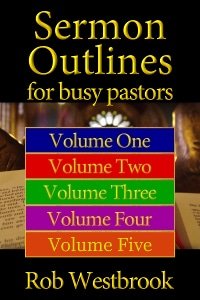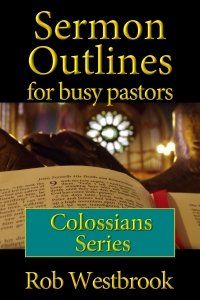Sermon Preparation - A Sermon Planning Template

A SERMON PREPARATION TOOL
When I first entered the ministry, I knew absolutely nothing about sermon preparation. Points, subpoints, introductions, conclusions, they meant nothing to me. I didn’t know expository from suppository!
My first sermon was a fulfillment of that old preacher’s saying, “Preach everything you know in ten minutes and then go over it again!” Well, I don’t know if you would consider it a sermon but I did. I was called by a very rural church to speak to their Brotherhood. If you’re not of the Southern Baptist persuasion, Brotherhood, in my experience, is a men’s gathering at church for breakfast and a speaker. The particular Brotherhood I spoke at had about 10 men there. I was scared to death.
That first experience did it for me. I was determined to learn how to better prepare sermons. I asked my pastor and other pastors for resources. My father-in-law gave me a box full of commentaries and other books. As I searched through that box, I found a book that got my attention. That book was Building Sermons to Meet People’s Needs by Harold T. Bryson.
I read the entire book. Then I read it again. I took notes. And more notes. I eventually built a sermon planning template from the book and my notes. That form became a way of helping me build a sermon outline that was focused and made sense.
While going through some old files on my computer a few years ago, I stumbled across that template. I have this template available as a free download here on my website. Some of you have already seen it, but I wanted to let all of you know about this valuable tool. (You can download the form at the bottom of this page)
The template has some terms and acronyms Dr. Bryson used in his book. I’ll try to explain some of those so they make sense, in case you try the template out.
ETS – ESSENSE OF THE TEXT IN A SENTENCE
You’ve selected a passage of Scripture you feel led to preach from. The ETS is a short, 15-word or so, sentence that sums up what that passage said. It’s the overarching central truth of that passage. Use the past tense for your sentence.
Example: John 3:16 ETS – God’s love compelled Him to provide eternal life to all who believe in Jesus.
ESS – ESSENSE OF THE SERMON IN A SENTENCE
Bryson calls the ESS the proposition. It’s the entire message and focus of the sermon in a nutshell. The ESS is also a short 15-word sentence. Use the present or future tense.
Example: John 3:16 ESS – Because of God’s love for you, He offers you eternal life through Jesus Christ.
OBJECTIVE – WHY AM I PREPARING THIS SERMON?
The objective is what your end goal is for preaching this sermon. What do you hope your sermon will cause people to do? What do you hope to accomplish? Again, as previously, the objective is a 15 word or so sentence in the present or future tense.
Example: John 3:16 OBJECTIVE – I want people to know they are truly loved by God which will lead them to believe in Jesus Christ
PROBING QUESTION – WHAT DO I WANT TO ACCOMPLISH?
The probing question is the approach you’ll use to present your objective. What direction do you want to go with your sermon? Let’s take the example objective above: I want people to know they are truly loved by God which will lead them to believe in Jesus Christ Take one of these seven words and apply to your objective to get your probing question: Who? What? Why? Which? When? Where? How?
Example: John 3:16 (A couple of examples) PROBING QUESTION – WHY does God truly love people and want them to believe in Jesus Christ? (The focus of the sermon will be on why God loves people enough to give them eternal life.) PROBING QUESTION – HOW can someone know they are truly loved by God and believe in Jesus Christ? (The focus of the sermon will be on how people can know God’s love and receive eternal life.)
UNIFYING WORD – TIES TOGETHER EACH DIVISION
This is the word that becomes the focal point of the sermon. It should be a plural noun or the plural noun form of a verb. It ties each point of your sermon together and gives you a target to hit in each point.
Example: John 3:16 From what we have developed so far in our examples, the unifying word is love. The plural form is loves. God loves is the focal point of the sermon and the overarching theme of the entire sermon. This will inform every point of the sermon as we develop it.
TRANSITIONAL SENTENCE
On the back of the template you write your introduction. The transitional sentence ties what you’ve introduced to the church with that you’re about to deliver through your sermon points.
Example: John 3:16 Let’s say you’re using an illustration of something every one can relate to, the love of a dog. Your dog is always there for you. You leave him for 5 minutes and when you come back, he acts like he hasn’t seen you in years. You have a bad day at work and when you get home, your dog doesn’t care. He just loves you. No matter your position in society or life, your dog doesn’t mind. He loves you unconditionally.
Transitional Sentence: The unconditional love your dog has for you pales in comparison to the way God loves you. Let’s dig into John 3:16 and see just how deeply God loves you.
MORE TO THE TEMPLATE
There’s much more to Bryson’s technique, all of which you’ll find in the template. But with just those elements discussed above, you are well on your way to preparing a well-formed, Biblically based sermon.
Again, the template is freely available for download. I hope you’ll give it a try. Maybe this approach will help freshen your sermon preparation.
Get a
FREE
Sermon Outlines
eBook
Get our ebook
Sermon Outlines for Busy Pastors: Colossians
FREE!
9 complete expository sermons for preaching every verse in
the book of Colossians.

